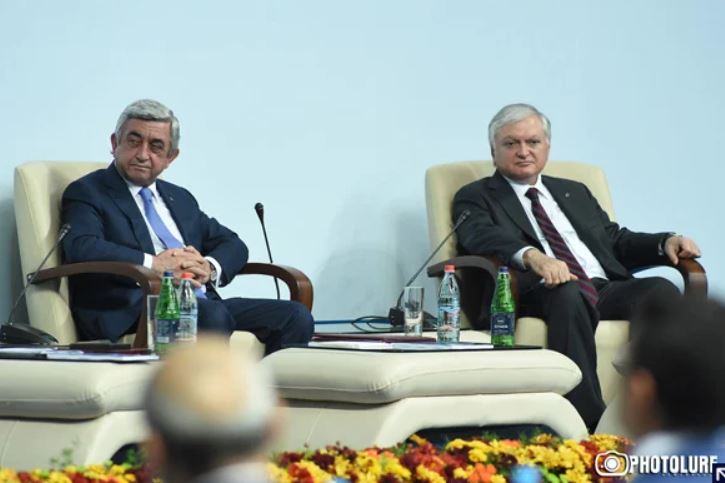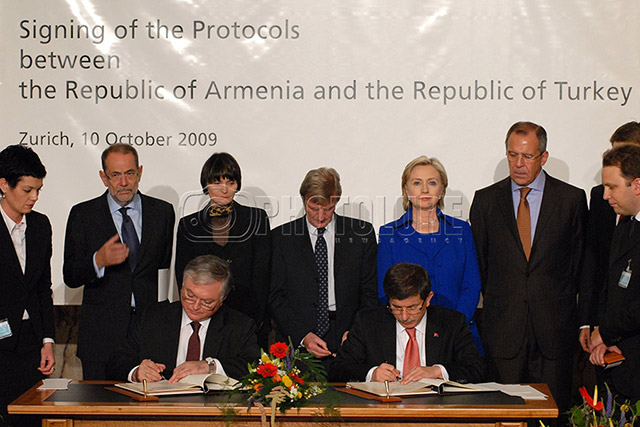Armenia’s Foreign Minister Edward Nalbandian’s Article in the Special Issue of «Politique Internationale» magazine
In the current world of drastic political changes, the international community and individual States occasionally do not manage to address issues, which at first glance do not seem urgent, even though there is an understanding that addressing them is of high importance.
Genocide prevention is one of such issues. The Armenian nation, which survived the first genocide of the 20th century, feels a strong moral responsibility to bring its contribution to international efforts in prevention of crimes against humanity. We have exerted our best efforts and will continue to do so for that purpose.
The recurrence of genocide or its threat is not a turned page for humanity. Genocide prevention always requires the constant attention and best efforts of the civilized world, without subordinating that noble humanitarian cause to any geopolitical calculations.
No single person can feel safe while there is an attempt to exterminate a whole ethnic group somewhere in the world. Every measure should be taken beforehand, first of all to prevent the genocidal environment from maturing into irreversible acts of violence.
Read also
Testimonies of the Armenian Genocide can be found in any part of the world, particularly where Armenians live. The Armenian people passed through the horrors of that tragedy in the Ottoman Empire. There was an attempt to strip millions of Armenians of their right to life, as well as their past — thousands of cultural and religious monuments were destroyed and the survivors were driven off the lands they had inhabited for many centuries.
One of the aspects inherent to the case of the Armenian Genocide is the presence of direct international obligations of the Ottoman Empire, which adhered towards the great powers at the Berlin Conference in 1878 “to carry out, without further delay, the ameliorations and reforms, which are called for by local needs in the provinces inhabited by Armenians and to guarantee their security” (1). Under the circumstances of continuous harassments of the Armenians in the Ottoman Empire, instead of improvement of the plight of the Armenians, the world witnessed Armenian massacres and pogroms. The most large-scale massacres before the genocide were committed by the Ottoman Sultan Abdul Hamid II between 1894 and 1896 when around 300,000 Armenians were killed, and in the 1909 Adana Massacres committed by the Young Turks, when around 30,000 Armenians were massacred.
Back then no effective measures were taken to call the perpetrators of these massacres to justice. The atmosphere of impunity largely contributed to yet more horrendous massacres of around 1.5 million Armenians, with World War I serving as a “suitable” cover for their implementation. Thus, the genocidal policy of the Ottoman Empire continued for more than a quarter of a century and culminated by what the Armenians called “Mets Yeghern” (The Great Calamity).
The first time the great powers paid a concerted attention to the massacres was on May 24, 1915, when the Allied Powers — Russia, France and Great Britain, adopted a special declaration warning the perpetrators of the atrocities against the Armenian people that they would be held personally responsible for “these new crimes of Turkey against humanity and civilization.” This was one of the first occasions of the use of the term “crimes against humanity” on an international level, leading to its elaboration as an inherent concept of the contemporary international legal system. In 1929 Winston Churchill characterized the Armenian massacres as a “holocaust” and added that “this crime was planned and executed for political reasons. The opportunity presented itself for clearing Turkish soil of a Christian race —” (2).
Nowadays some Turkish narratives are presenting their own perceptions of history as the only true ones, a “just memory” into which other peoples’ memories should fit. This is an exercise against memory and history. The study of history suffers when memory is applied selectively, when “the organized murder of the Armenian race” (3) is presented as imaginative memory of the descendants of the survivors. In fact, the Armenian Genocide is a part of the memory and history of the Armenian nation and of humanity as a whole, including the Muslim world. One of the earliest references to the Armenian Genocide comes from a Muslim witness, Fayez El Ghossein (4), who in 1916 published his work entitled “The Massacres in Armenia.” Sharif of Mecca Hussein ibn Ali al-Hashimi (5) was one of the prominent Islamic leaders, who acted against the annihilation of the Armenians and called on his subjects to defend Armenians as they would defend themselves and their children. In 1919-1921 Turkish public figures such as Refi Cevat (6), Ahmet Refik Altinay (7) and many others referred to the large scale extermination of Armenians. Many Muslim historians refer to the massacres of Armenians as genocide, while Arab historian Moussa Prince used the term “Armenocide”, considering it as “the most genocidal genocide” (8).
The Arab authors Fuad Hasan Hafiz, Samir Arbash and others defined the Armenian Genocide as “the blood page in the history of mankind of the 20th century” (9). It was the absence of the unequivocal condemnation and elimination of consequences of the Armenian Genocide that made the young philologist Rafael Lemkin in 1921 ask his professor why the Armenians did not have the masterminds of the Armenian Calamity prosecuted. To that question his professor replied that there was no law under which they could be brought to justice. Afterwards Lemkin decided to get immersed in international law dedicating his life to the study of crimes against humanity, which, among others, paved the way for the adoption of the 1948 Convention. Lemkin alluded that he defined the term genocide also by referring to the very policy of mass extermination perpetrated against Armenians. It was the Shoah that pushed the international community to codify the crime of genocide through the 1948 Convention on the Prevention and Punishment of the Crime of Genocide. The following seven decades have demonstrated that all good-will is not enough to exclude genocides and crimes against humanity from happening again.
Close examination of the genocides of the 20th century demonstrates that the perpetrators of genocides in different geographical areas and different historical periods have been “skilled enough” to identify the tactics of their murderous predecessors and learn from them. The Young Turk’s Committee of Union and Progress in Turkey, the National Socialist German Workers’ Party in Germany, and the Hutu National Revolutionary Movement for Democracy in Rwanda all used special paramilitary organizations as the main perpetrators of mass killings. These were Teskilat Mahsusa, the Schutzstaffel, Interahamwe (10). These as well as other crimes against humanity had many other similarities in the genocidal practices, such as the treatment of victims, expropriation of their properties and ways of extermination. Oppressions, intolerance towards and demonization of the representatives of ethnic, religious, minority and other groups and their cultural heritage, and limited ethnic cleansings could indicate the emergence of genocidal atmospheres, and require immediate, unconditional and united preventive efforts from the international community.
The failure to prevent genocide in one place provides a solid ground for its recurrence in other places. In this context many refer to Hitler’s quotation from August 1939 when he rhetorically asked “Who still talks nowadays of the extermination of the Armenians?” (11).
Genocides do not occur according to a single model and in order to develop preventive mechanisms we should have an accurate understanding of the history of genocides, their causes, the methods of implementation and the subsequent developments. At the same time, we must be ready to learn from past failures and be ready for new challenges.
One of the main contemporary documents enclosing the main measures for the prevention of the crime of genocide is the UN Human Rights Council Resolution of 22nd March 2013, initiated by Armenia and co-sponsored by 62 countries. It envisages the necessary international measures for genocide prevention. Particularly, we can see the three main pillars of genocide prevention: early warning, human rights protection, and public campaign for education and awareness. These pillars include a number of components.
First, the convention envisages that the international community must be aware of the risk of genocide as early as possible in order to react promptly, before it is too late. Usually perpetrators of genocides try to hide their intentions as long as possible. However, it is quite hard for them to cover up the preparation of such grave crimes for a long time. Hence the international community and particularly international organizations should evaluate the origins of genocidal atmosphere leading to this heinous crime and effectively prevent it.
Over the course of the past decade both the United Nations and the regional bodies, as well as some human rights NGO s, have made much progress in improving early warning and assessment systems. We should do our utmost to ensure that these advances continue in the years ahead. Early identification and warning by themselves will not be effective unless they are followed by concrete mechanisms of deterrence and protection.
Second, prevention of genocide is a part of the complex international mechanisms of the human rights protection. This is the basic and most efficient way to exclude the possibility of the occurrence of a genocidal atmosphere in a society. Strong legal traditions and moral values stand on the most important defense line against these horrible crimes. Genocide is an unthinkable crime for a society which is founded on the protection of human rights, on the values of mutual respect, tolerance and non-violence. In other words, genocide is dead before it is born in a society with strong human rights protection traditions and vice versa — human rights protection is basically non-existent wherever genocide occurs.
The connecting chain of human rights protection and genocide prevention is the protection of ethnic, religious and other minorities’ rights. For most cases of genocide the main objective of the perpetrators is the extermination of an ethnic minority. Reasons for such a crime may be the wish to prevent a minority group from implementing its right to self-determination. In order to rule out the possibility of such developments the international community should particularly assist the States that have a diverse ethnic population to maintain proper human rights protection and particularly minority rights protection.
Moreover wherever it is necessary, the international community should support the peaceful implementation of the right to self-determination of the peoples. As it was mentioned in a recent report by an Independent Expert, Alfred-Maurice de Zayas for the UN , rather than perceiving self-determination as a source of conflict, a better approach is to see armed conflict as a consequence of the violation of self-determination (12).
Finally, the third pillar of goals envisaged in the UN Human Rights Council Resolution is to raise public awareness through education and remembrance. Generations should get accurate knowledge of the history of past tragedies, past genocides. The full acknowledgement and condemnation of committed genocides are one of the most effective tools for the prevention of their reoccurrence in the future. This is particularly an important condition for the possibility of an effective reconciliation among peoples who directly encountered genocide. The right of people to their memory, their right to knowledge of the history of past tragedies through education and remembrance has pivotal roles on preventing and condemning genocide.
Genocide scholars nowadays consider genocide denial as one of the stages of genocide. According to the Genocide Watch following classification, symbolization, discrimination, dehumanization, organization, polarization, preparation, persecution and extermination, the denial is classified as the final stage that lasts throughout and always follows genocide (13). It is among the surest indicators of further genocides, because along with impunity, denial paves the way for the repetition of new crimes against humanity. Independently of geopolitical or any other interests, all members of the international community should stand together in the recognition, condemnation and punishment of past genocides, especially in light of the 1968 Convention on the Non-Applicability of Statutory Limitations, in their efforts towards their prevention in the future. As it is mentioned in the preamble of the abovementioned resolution, the impunity for the crime of genocide, war crimes and crimes against humanity encourages their occurrence and is a fundamental obstacle to the furtherance of cooperation among peoples and the promotion of international peace and security. Fighting impunity for such crimes is an important factor in their prevention. Genocide remembrance days should be days of mourning not only for the descendants of victims, but for the descendants of the perpetrators. These days should be approached with commitment to move towards recognition and reconciliation. The true reconciliation cannot be achieved by forgetting the past, feeding younger generations with tales of denial.
Moreover, in the current globalized world it is gradually becoming impossible for a State to conceal from its own society all the facts concerning the tragic events of the past. Hence, continuing the policy of denial and falsification of facts simply widens the gap of understanding between the very government and the society in a State which or the predecessor of which perpetrated genocide.
The civilized world should resolutely reject the incitement to hatred, racism, dissemination of intolerance, denial of genocide, and crimes against humanity under the guise of freedom of expression. One of the tools of denial nowadays is the minimization of the suffering of the victims, trivialization of the scale of the losses and equation of the sufferings of the victims and the perpetrators. Recently, we have often witnessed this new tactic of “soft denial”.
These are the main measures that are envisaged for the prevention of the reoccurrence of genocides. But whatever measures we take, we cannot expect effective results unless there is a proper realization of how important it is to prevent any occurrence of genocide and without sufficient will by the members of the international community to take practical steps whenever it is necessary. No matter how often we take measures for the prevention of genocides, these efforts will be rewarded if we observe and enforce all available prevention tools. As exactly a century ago, nowadays too, witnessing new attempts at genocides and new tactics of their denials, the issue of preventing crimes against humanity is still imperative.
(1) Berlin Treaty, July 13, 1878, Full text in English available at https://trove.nla.gov.au/ndp/del/article/18830646
(2) Winston Churchill, The Aftermath, London, 1929, p. 158.
(3) Arnold Toynbee, Armenian Atrocities: the Murder of a Nation, London, 1915, p. 106.
(4) Faiz al-Ghosein, Mazabih fi Arminiya, Al-Masadir al-Arabiya Hawla Jarima Ibadati al-Arman, Beirut, 1988.
(5) Hussein ibn Ali al-Hashimi in a decree in 1917 requested from the Arab leaders — Prince Faisal and Prince Abd al-Aziz al-Jarba “to help the Armenian people in every way and defend them as you defend your own self, your children and your property” — original handwritten decree is preserved in the Royal Hashemite Court Archive in Jordan.
(6) Refi Cevat, Gördüklerimizden ve İşittiklerimizden, “Alemdar”, 20 Kânunuevvel 1918; Gördüklerimiz ve İşittiklerimiz, ZÖHRAB VE VAR TKES EFENDİLER DİYARI BEKİR YOLUNDA , “Alemdar”, 22 Kânunusani 1919; Osmanlılar ve Mesuliyete Teşrik, “Alemdar”, 18 Kânunusani 1919.
(7) Ahmet Refik, İki Komite İki Kıtal, İstanbul, 1998.
(8) Moussa Prince, Un genocide impuni. L’Armenocide, Heidelberg Press, Lebanon, 1967, pp. 26-27.
(9) Fuad Hasan Hafez, Fuad Hasan Hafiz., Tarikh al-shaabi al-Armani munzu al badayati hatta al-yaum, al-Kahira, 1986, p. 297; Samir Arbash, Arminiya, Ard va shaab, Beirut, 1991, p 165
(10) Michael Mann, The Dark Side of Democracy, Explaining Ethnic Cleansing, Cambridge, 2005
(11) The New York Times, November 24 (Saturday), VOL . LCV No. 32,081, 1945
(12) Interim report of the Independent Expert on the promotion of a democratic and equitable international order, UN Doc. A/69/272, August 7, 2014, https://daccess-dds-ny.un.org/doc/UNDOC/GEN/N14/497/95/PDF/N1449795.pdf?OpenElement; See, also, Statement by Alfred-Maurice de Zayas, Independent Expert on the promotion of a democratic and equitable international order at the 69th session of the General Assembly, New York, 27 October 2014https://www.ohchr.org/EN/NewsEvents/Pages/DisplayNews.aspx?NewsID=15278&LangID=E#sthash.bEx7nJOC.dpuf
(13) Gregory Stanton (President of the genocide Watch), “The Ten Stages of Genocide”, 2013,
https://www.genocidewatch.org/genocide/tenstagesofgenocide.html
URL: https://www.mfa.am/en/interviews/item/2015/04/20/min_polint_sped/























































